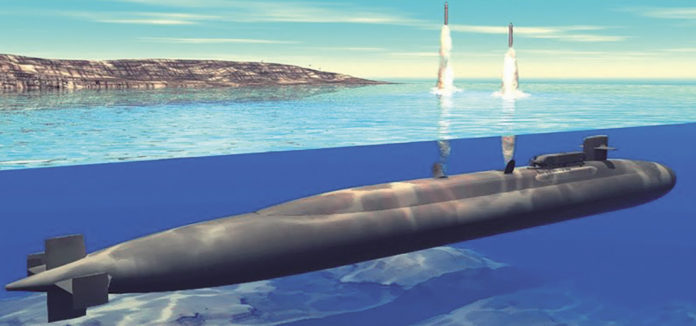
The Defence Research and Development Organsiation (DRDO) successfully test-fired the 3,500-km range submarine-launched ballistic missile (SLBM), K-4, on 18 January, from a submerged pontoon off the Visakhapatnam coast. The test met the desired parameters. A pontoon simulates the situation of a launch from a submarine.
What makes this test-firing of the K-4 missile more significant is the fact that a recent launch of the missile, conducted from a submerged platform in December 2017, had ended in a failure. The launch was not successful due to “a failure in the missile’s ignition following its ejection from the submerged pontoon.”
SLBMs are test-fired from submerged platforms not only to collect data to analyse its performance, but also to ensure safety. A failed launch from an active ballistic missile submarine would cause massive damage to its hull.
Developmental testing of the missile, which has an estimated maximum range of 3,500 kilometers and can be fitted with a 2,000-kilogram sub-kiloton nuclear or conventional payload, began in 2010.
The K-4 was last successfully test fired in full operational configuration from India’s first domestically developed and built nuclear-powered ballistic missile submarine (SSBN), the INS Arihant, in April 2016. Notably, the K-4 has been tested using depressed trajectories.
The INS Arihant, the first-of-class of a planned fleet of four to five SSBNs based on the Russian Project 971 Akula I-class nuclear-powered attack submarine (SSN), has been designed to carry up to four K4s or 12 K-15 (B-05) short-range ballistic missiles (SLBM).
With the K-4, INS Arihant and future SSBNs will be able to target parts of China, including Beijing, and all of Pakistan, from the northern parts of the Bay of Bengal. Not ideal, but better than the K-15.
K-15 Sagarika
Three K-15s were successfully launched from the Arihant in August 2018. The K-15 Sagarika is a solid-fueled two-stage SLBM capable of carrying a single warhead and has a reported maximum range of 700 to 750 kilometers. It has been under development by India’s DRDO since the 1990s. Another test firing of a K-15 SLBM from the INS Arihant took place in November 2015.
INS Arihant, the first and only operational SSBN, is armed with K-15 Sagarika missiles with a range of 750 km. It has a displacement of 6,000 tonnes and is powered by an 83 MW pressurised light-water reactor with enriched uranium. The K-4 will do away with the need to venture far way from the Indian waters and move closer to the adversary’s coast to launch the missile.
There are very few countries which have managed to achieve this technological breakthrough. The Circular Error Probability (CEP) was much more sophisticated than Chinese missiles. The CEP determines the accuracy of a missile. The lower the CEP, the more accurate the missile is. The missile has been tested several times earlier as part of developmental trials to validate different parameters.
Once inducted, these missiles will be the mainstay of the Arihant class of indigenous ballistic missile nuclear submarines (SSBN) and will give India the stand-off capability to launch nuclear weapons submerged in Indian waters.
Nuclear Triad
In November 2019, India formally declared its nuclear triad stated in its nuclear doctrine operational after INS Arihant completed its first deterrence patrol, which means Arihant has begun prowling the deep seas carrying ballistic missiles equipped with nuclear warheads. It was quietly commissioned into service in August 2016 and its induction was not officially acknowledged.
Given the Arihant’s primary role as a technology demonstrator, it will likely take the Indian Navy at least until 2021-when the second Arihant-class SSBN the future INS Arighant (originally assumed to be named Aridhaman) is set to enter service – to achieve an operational long-range nuclear strike capability.
Towards Credible Deterrence
For a credible at-sea deterrence, a country’s SSBNs must be capable of, among other things, targeting population and industrial centres of the adversary. In India’s case, this means that the Indian Navy’s SSBNs must be capable of holding at risk cities not only in Pakistan but also in the Chinese mainland.
Cities in the Chinese mainland would remain outside the range of the missile even if the boat was at the north-eastern edge of the Bay of Bengal. Therefore, in the event of a crisis with Beijing, New Delhi would not have the option of threatening a nuclear attack on a target of consequence in China. (Theoretically, the SSBN can reach closer to China to make up for the short-range of the missile, but it will be at an increased risk of detection or worse – an attack).
Therefore, India may have operationalised its triad, but the naval leg or the at-sea deterrent is not credible given the limited range of the missile it uses.
The DRDO, reports say, is already working on 5,000-km range K-5 and 6,000-km range K-6 SLBMs.

















